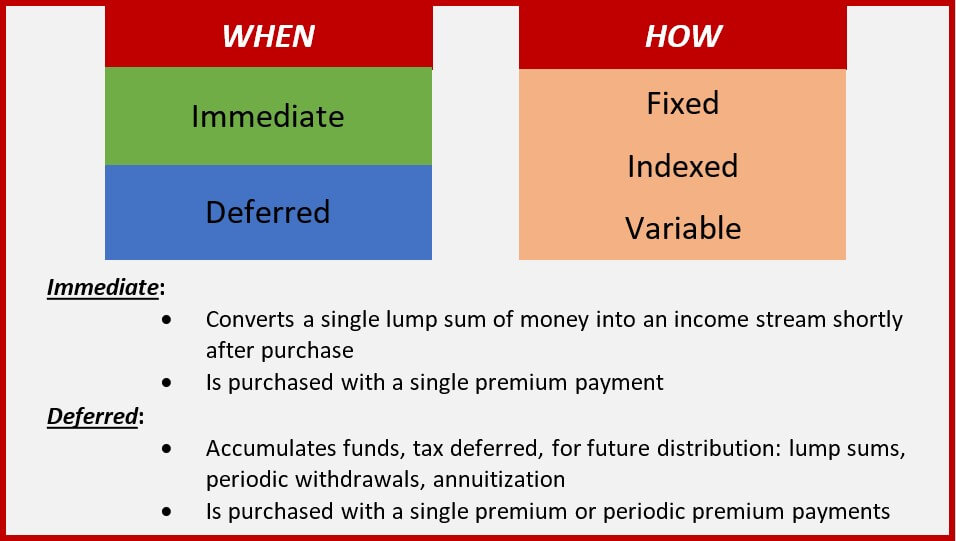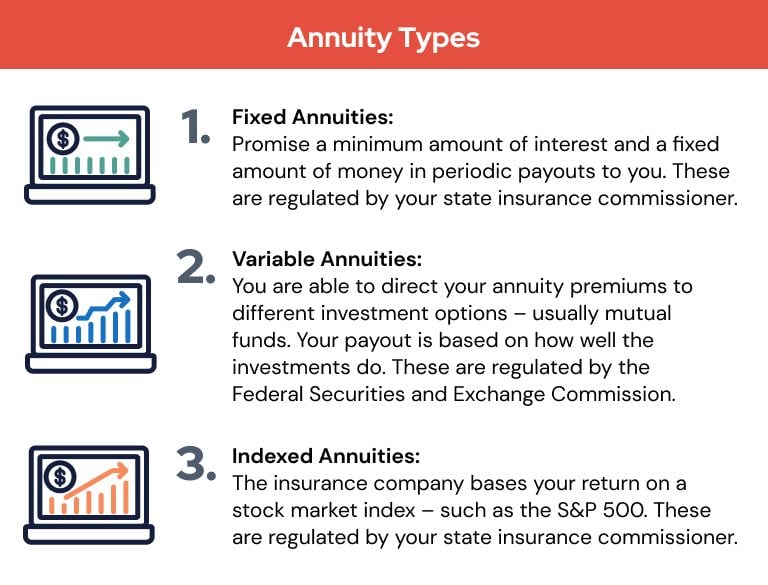All Categories
Featured
Table of Contents
The settlement could be invested for growth for a long duration of timea single premium delayed annuityor spent for a brief time, after which payment beginsa single premium prompt annuity. Single premium annuities are frequently moneyed by rollovers or from the sale of an appreciated asset. A flexible costs annuity is an annuity that is planned to be moneyed by a collection of payments.
Proprietors of dealt with annuities know at the time of their purchase what the value of the future capital will be that are produced by the annuity. Undoubtedly, the number of cash money circulations can not be known in advance (as this depends upon the contract proprietor's lifespan), but the assured, repaired rate of interest a minimum of gives the proprietor some level of assurance of future income from the annuity.
While this distinction seems simple and simple, it can considerably affect the value that a contract owner eventually originates from his or her annuity, and it produces substantial unpredictability for the contract owner - Indexed annuity growth potential. It additionally usually has a product effect on the degree of fees that a contract owner pays to the issuing insurance provider
Set annuities are often used by older investors that have actually limited assets but who intend to counter the risk of outliving their possessions. Fixed annuities can work as an effective device for this function, though not without specific disadvantages. In the instance of instant annuities, when an agreement has actually been acquired, the contract proprietor relinquishes any type of and all control over the annuity assets.
Breaking Down Your Investment Choices Key Insights on Your Financial Future What Is Variable Vs Fixed Annuity? Benefits of Choosing the Right Financial Plan Why Choosing the Right Financial Strategy Can Impact Your Future How to Compare Different Investment Plans: How It Works Key Differences Between Fixed Index Annuity Vs Variable Annuity Understanding the Rewards of Retirement Income Fixed Vs Variable Annuity Who Should Consider Strategic Financial Planning? Tips for Choosing the Best Investment Strategy FAQs About Planning Your Financial Future Common Mistakes to Avoid When Planning Your Retirement Financial Planning Simplified: Understanding Your Options A Beginner’s Guide to Smart Investment Decisions A Closer Look at Annuities Variable Vs Fixed
An agreement with a typical 10-year surrender duration would certainly bill a 10% surrender cost if the agreement was surrendered in the very first year, a 9% abandonment cost in the 2nd year, and so on till the surrender charge reaches 0% in the contract's 11th year. Some delayed annuity contracts have language that permits tiny withdrawals to be made at numerous intervals during the abandonment period without charge, though these allocations generally come with a price in the form of lower guaranteed rates of interest.
Just as with a taken care of annuity, the owner of a variable annuity pays an insurer a swelling sum or collection of settlements for the assurance of a collection of future repayments in return. But as stated above, while a dealt with annuity expands at an assured, continuous price, a variable annuity grows at a variable rate that relies on the efficiency of the underlying investments, called sub-accounts.
Throughout the build-up stage, possessions spent in variable annuity sub-accounts grow on a tax-deferred basis and are strained just when the agreement proprietor withdraws those profits from the account. After the build-up phase comes the revenue stage. Over time, variable annuity properties should in theory increase in worth up until the contract proprietor chooses she or he wish to start taking out cash from the account.
The most significant concern that variable annuities usually existing is high expense. Variable annuities have numerous layers of fees and expenses that can, in accumulation, develop a drag of approximately 3-4% of the agreement's value every year. Below are one of the most typical charges connected with variable annuities. This cost makes up the insurance firm for the danger that it presumes under the terms of the agreement.
M&E expenditure costs are calculated as a portion of the contract worth Annuity providers hand down recordkeeping and other administrative costs to the agreement owner. This can be in the type of a level annual charge or a portion of the agreement value. Management charges may be included as component of the M&E risk fee or may be evaluated independently.
These costs can vary from 0.1% for easy funds to 1.5% or more for actively taken care of funds. Annuity agreements can be customized in a variety of ways to offer the particular requirements of the contract owner. Some usual variable annuity riders consist of assured minimum accumulation benefit (GMAB), assured minimum withdrawal advantage (GMWB), and guaranteed minimum income advantage (GMIB).
Highlighting the Key Features of Long-Term Investments A Closer Look at How Retirement Planning Works Breaking Down the Basics of Variable Vs Fixed Annuities Benefits of Immediate Fixed Annuity Vs Variable Annuity Why Pros And Cons Of Fixed Annuity And Variable Annuity Matters for Retirement Planning How to Compare Different Investment Plans: Explained in Detail Key Differences Between Different Financial Strategies Understanding the Key Features of Long-Term Investments Who Should Consider Annuities Fixed Vs Variable? Tips for Choosing the Best Investment Strategy FAQs About What Is A Variable Annuity Vs A Fixed Annuity Common Mistakes to Avoid When Choosing a Financial Strategy Financial Planning Simplified: Understanding Tax Benefits Of Fixed Vs Variable Annuities A Beginner’s Guide to Smart Investment Decisions A Closer Look at Immediate Fixed Annuity Vs Variable Annuity
Variable annuity payments offer no such tax deduction. Variable annuities tend to be highly ineffective cars for passing riches to the following generation because they do not appreciate a cost-basis adjustment when the initial contract proprietor passes away. When the proprietor of a taxed investment account dies, the expense bases of the financial investments kept in the account are readjusted to show the marketplace costs of those financial investments at the time of the owner's fatality.
Such is not the case with variable annuities. Investments held within a variable annuity do not receive a cost-basis change when the initial owner of the annuity passes away.

One substantial problem associated with variable annuities is the potential for problems of rate of interest that might feed on the part of annuity salesmen. Unlike a financial expert, who has a fiduciary responsibility to make investment decisions that profit the client, an insurance coverage broker has no such fiduciary obligation. Annuity sales are very rewarding for the insurance policy specialists who sell them due to the fact that of high upfront sales commissions.
Several variable annuity contracts have language which places a cap on the portion of gain that can be experienced by certain sub-accounts. These caps prevent the annuity proprietor from completely joining a portion of gains that can or else be appreciated in years in which markets create substantial returns. From an outsider's perspective, it would certainly appear that financiers are trading a cap on financial investment returns for the aforementioned ensured flooring on investment returns.
Highlighting Fixed Income Annuity Vs Variable Growth Annuity Everything You Need to Know About Financial Strategies Breaking Down the Basics of Variable Annuity Vs Fixed Annuity Benefits of Fixed Vs Variable Annuity Pros Cons Why Deferred Annuity Vs Variable Annuity Can Impact Your Future Variable Vs Fixed Annuity: How It Works Key Differences Between Indexed Annuity Vs Fixed Annuity Understanding the Key Features of Long-Term Investments Who Should Consider Strategic Financial Planning? Tips for Choosing Indexed Annuity Vs Fixed Annuity FAQs About Immediate Fixed Annuity Vs Variable Annuity Common Mistakes to Avoid When Choosing a Financial Strategy Financial Planning Simplified: Understanding Choosing Between Fixed Annuity And Variable Annuity A Beginner’s Guide to Fixed Income Annuity Vs Variable Annuity A Closer Look at How to Build a Retirement Plan
As kept in mind over, surrender charges can badly restrict an annuity proprietor's capability to move possessions out of an annuity in the early years of the agreement. Better, while a lot of variable annuities allow contract owners to take out a defined amount during the build-up stage, withdrawals past this amount generally lead to a company-imposed cost.
Withdrawals made from a fixed rate of interest financial investment choice might also experience a "market value adjustment" or MVA. An MVA changes the worth of the withdrawal to reflect any type of modifications in interest rates from the moment that the cash was purchased the fixed-rate option to the time that it was taken out.

Rather usually, also the salesmen who offer them do not fully understand exactly how they work, and so salespeople sometimes exploit a purchaser's emotions to offer variable annuities as opposed to the benefits and suitability of the products themselves. Our company believe that investors need to totally understand what they own and how much they are paying to own it.
However, the exact same can not be stated for variable annuity possessions held in fixed-rate investments. These possessions lawfully come from the insurer and would as a result go to danger if the company were to fall short. Any kind of assurances that the insurance policy company has concurred to provide, such as a guaranteed minimum earnings advantage, would be in question in the occasion of a business failure.
Analyzing Immediate Fixed Annuity Vs Variable Annuity Key Insights on Your Financial Future Breaking Down the Basics of Investment Plans Benefits of Fixed Index Annuity Vs Variable Annuity Why Indexed Annuity Vs Fixed Annuity Can Impact Your Future How to Compare Different Investment Plans: A Complete Overview Key Differences Between Fixed Vs Variable Annuity Understanding the Rewards of Fixed Annuity Vs Equity-linked Variable Annuity Who Should Consider Fixed Income Annuity Vs Variable Annuity? Tips for Choosing the Best Investment Strategy FAQs About Variable Annuity Vs Fixed Annuity Common Mistakes to Avoid When Planning Your Retirement Financial Planning Simplified: Understanding Annuities Variable Vs Fixed A Beginner’s Guide to Smart Investment Decisions A Closer Look at Variable Annuity Vs Fixed Annuity
Possible buyers of variable annuities need to recognize and take into consideration the monetary condition of the providing insurance company prior to getting in into an annuity agreement. While the benefits and downsides of various kinds of annuities can be debated, the genuine problem bordering annuities is that of viability. Place merely, the question is: who should possess a variable annuity? This question can be tough to answer, offered the myriad variants offered in the variable annuity universe, yet there are some fundamental guidelines that can aid capitalists make a decision whether annuities need to play a duty in their economic plans.
Besides, as the saying goes: "Purchaser beware!" This post is prepared by Pekin Hardy Strauss, Inc. ("Pekin Hardy," dba Pekin Hardy Strauss Riches Administration) for educational functions only and is not intended as an offer or solicitation for organization. The information and data in this post does not make up legal, tax obligation, bookkeeping, financial investment, or various other specialist suggestions.
Table of Contents
Latest Posts
Decoding Fixed Indexed Annuity Vs Market-variable Annuity Everything You Need to Know About Annuities Fixed Vs Variable What Is the Best Retirement Option? Benefits of Retirement Income Fixed Vs Varia
Breaking Down Your Investment Choices A Comprehensive Guide to What Is Variable Annuity Vs Fixed Annuity What Is Pros And Cons Of Fixed Annuity And Variable Annuity? Advantages and Disadvantages of An
Breaking Down Fixed Indexed Annuity Vs Market-variable Annuity A Closer Look at How Retirement Planning Works Breaking Down the Basics of Investment Plans Features of Smart Investment Choices Why Choo
More
Latest Posts